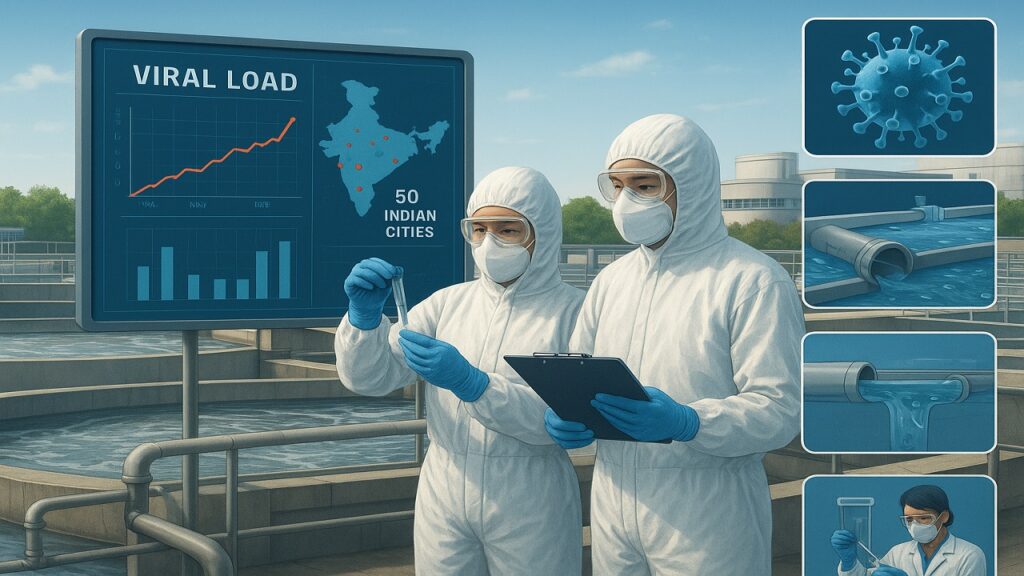Context:

- The Indian Council of Medical Research (ICMR) has announced plans to implement wastewater surveillance for 10 viruses across 50 cities.
- This is part of broader environmental surveillance measures aimed at early detection of viral outbreaks, monitoring disease burden, and improving public health preparedness.
- Environmental surveillance complements clinical surveillance by capturing data from asymptomatic individuals who do not report to healthcare facilities.
What is Environmental Surveillance?
- Definition: Systematic monitoring and collection of samples from air, water, soil, food, waste, and vectors to detect pathogens, pollutants, or hazardous materials.
- Purpose: To provide community-level insights into health threats, which may not be visible through clinical data alone.
Process of Environmental Surveillance:
- Planning & Site Selection: Identify sources like air, water, soil, sewage, food, and vectors.
- Sample Collection: Collect air filters, wastewater, soil, swabs, and food samples.
- Laboratory Analysis: Test for pathogens, chemicals, toxins, and pollutants.
- Data Recording & Interpretation: Analyze trends, anomalies, and risk levels.
- Early Warning & Risk Assessment: Detect potential threats to public health and environment.
- Response & Control Measures: Implement sanitation, vaccination, or pollution control.
- Reporting & Feedback: Share findings with government agencies, health authorities, and communities.
- Continuous Monitoring: Repeat regularly for trend analysis and early outbreak detection.
Components of Environmental Surveillance
- Air Surveillance: Tracks airborne pathogens, pollutants, and greenhouse gases.
- Water Surveillance: Monitors drinking water, wastewater, and sewage.
- Soil Surveillance: Detects industrial effluents, pesticides, and heavy metals.
- Food Chain Surveillance: Monitors toxins, pathogens, and pesticide residues.
- Vector & Animal Surveillance: Observes disease-carrying vectors and zoonotic pathogens.
- Waste Surveillance: Monitors biomedical, industrial, and solid waste.
- Radiological & Chemical Surveillance: Measures hazardous chemicals and radiation levels.
- Climate & Meteorological Surveillance: Records weather patterns and long-term climate changes.
Purposes of Environmental Surveillance
- Disease Monitoring: Detects viruses and bacteria in asymptomatic individuals, e.g., COVID-19, polio, influenza.
- Early Warning System: Provides days-to-weeks advance notice of potential outbreaks.
- Environmental Hazard Tracking: Monitors chemical spills, radiation, and pollution.
- Assessing Public Health Interventions: Evaluates effectiveness of vaccination and sanitation measures.
- Resource Allocation: Enables evidence-based allocation of testing, vaccines, and resources.
- Limitations of Traditional Surveillance: Clinical reporting misses asymptomatic or untested individuals.
Wastewater Surveillance: How It Works
- Sample Collection: From sewage treatment plants, hospitals, public toilets, railway stations, and airplanes.
- Rationale: Pathogens are shed in stools and urine, enabling community-level detection.
- Monitoring: Detects parasitic infections, viral pathogens, and antibiotic resistance.
- Protocol Development: Standardized procedures ensure accurate detection and variant identification via whole-genome sequencing.
- Data Insights: Helps assess disease prevalence and effectiveness of control measures.
Significance of Early-Warning Signals
- Public Health Planning: Understanding pathogen load helps prepare health systems.
- Disease Mitigation: Enables timely interventions to reduce spread.
- Historical Use: Wastewater surveillance has tracked polio, cholera, measles, and during COVID-19.
- India’s Experience: Mumbai started polio wastewater monitoring in 2001, followed by COVID-19 surveillance in five cities.
ICMR Initiative and Future Directions
- Current Plan: Wastewater surveillance for 10 viruses across 50 cities to detect rising viral loads early.
- Focus Areas: Includes avian influenza and outbreak-prone regions.
- Improvement Measures:
- Data Sharing: Standardized protocols across institutions.
- Programmatic Approach: Integrate wastewater surveillance with routine disease monitoring.
- National System Development: Build a comprehensive nationwide wastewater surveillance network.
- Emerging Techniques: Use audio-based and AI methods to track respiratory conditions.
Conclusion
- The ICMR’s wastewater surveillance initiative strengthens India’s public health preparedness.
- By leveraging environmental monitoring, it provides early warning of outbreaks, accurate disease burden data, and evaluation of interventions.
- This proactive approach ensures timely mitigation measures and improves community-level health security across urban and rural India.
Source : The Hindu
